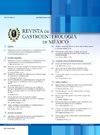Tumores neuroendocrinos gastroenteropancreáticos: un estudio retrospectivo en el suroccidente colombiano
IF 1.7
Q3 GASTROENTEROLOGY & HEPATOLOGY
引用次数: 0
Abstract
Introduction and aim
Gastroenteropancreatic neuroendocrine tumors (GEP-NETs) are rare neoplasms originating in neuroendocrine cells from the gastric mucosa and submucosa, small intestine, large intestine, rectum, and pancreas. Our aim was to describe their histopathologic, endoscopic, and clinical characteristics and the experience with these tumors at a tertiary care hospital center in the Colombian Southwest.
Materials and methods
A retrospective, analytic, observational, and descriptive study included 93 patients diagnosed with GEP-NETs, within the time frame of 2018 and 2022. Their clinical histories were reviewed to collect the sociodemographic, clinical, endoscopic, pathologic, treatment, follow-up, and survival data.
Results
Median patient age was 55.8 years, and 60.2% were women. A total of 78.5% of the patients presented with symptoms, the most common of which was abdominal pain (78.1%). The tumors were mainly located in the stomach (32.3%) and small intestine (23.7%). Histopathologically, 53.8% of the tumors were grade 1, 30.1% were grade 2, 9.68% were grade 3, and 7.52% were carcinomas. Tumor location was significantly related to stage; the majority of tumors in stage I were in the stomach, whereas the stage IV tumors were in the small intestine. At the last evaluation, 40.9% of the patients were disease-free, disease was stable in 24.7% and progressive in 11.8%, and 18.3% of the patients died.
Conclusions
GEP-NETs are clinically heterogeneous, and their early diagnosis is dependent on the recognition of lesions in endoscopic and imaging studies. Early tumors are mainly located in the stomach and advanced tumors in the small intestine, with metastases in the liver and regional lymph nodes. The present study suggests the importance of disease awareness in the early detection of GEP-NETs; said factor, combined with timely interdisciplinary management, could significantly impact patient outcomes.
胃肠胰腺神经内分泌肿瘤:哥伦比亚西南部的回顾性研究
胃肠胰神经内分泌肿瘤(gastroenteroppancreatic neuroendocrine tumors, GEP-NETs)是一种罕见的肿瘤,起源于胃粘膜和粘膜下层、小肠、大肠、直肠和胰腺的神经内分泌细胞。我们的目的是描述他们的组织病理学、内窥镜和临床特征,以及在哥伦比亚西南部三级护理医院中心治疗这些肿瘤的经验。材料和方法一项回顾性、分析性、观察性和描述性研究纳入了2018年至2022年期间诊断为GEP-NETs的93例患者。我们回顾了他们的临床病史,收集了社会人口学、临床、内镜、病理、治疗、随访和生存数据。结果患者中位年龄为55.8岁,60.2%为女性。共有78.5%的患者出现症状,最常见的是腹痛(78.1%)。肿瘤主要位于胃(32.3%)和小肠(23.7%)。病理组织学上,1级占53.8%,2级占30.1%,3级占9.68%,癌占7.52%。肿瘤位置与分期显著相关;I期肿瘤多发生在胃,而IV期肿瘤多发生在小肠。末次评估时,40.9%的患者无病,24.7%的患者病情稳定,11.8%的患者病情进展,18.3%的患者死亡。结论gep - nets具有临床异质性,其早期诊断依赖于内镜和影像学检查对病变的识别。早期肿瘤以胃为主,晚期肿瘤以小肠为主,可转移至肝脏和局部淋巴结。本研究提示疾病意识在早期发现全球环境-网络中的重要性;上述因素,结合及时的跨学科管理,可以显著影响患者的预后。
本文章由计算机程序翻译,如有差异,请以英文原文为准。
求助全文
约1分钟内获得全文
求助全文
来源期刊

Revista de Gastroenterologia de Mexico
GASTROENTEROLOGY & HEPATOLOGY-
CiteScore
1.60
自引率
12.50%
发文量
102
审稿时长
12 weeks
期刊介绍:
La Revista de Gastroenterología de México es el órgano oficial de la Asociación Mexicana de Gastroenterología. Sus espacios están abiertos a los miembros de la Asociación como a todo miembro de la comunidad médica que manifieste interés por utilizar este foro para publicar sus trabajos, cumpliendo con las políticas editoriales que a continuación se mencionan. El objetivo principal de la Revista de Gastroenterología de México, es publicar trabajos originales del amplio campo de la gastroenterología, así como proporcionar información actualizada y relevante para el área de la especialidad y áreas afines. Los trabajos científicos incluyen las áreas de Gastroenterología clínica, endoscópica, quirúrgica y pediátrica.
 求助内容:
求助内容: 应助结果提醒方式:
应助结果提醒方式:


